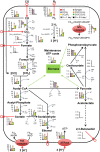Enhancing CO2-Valorization Using Clostridium autoethanogenum for Sustainable Fuel and Chemicals Production
- PMID: 32292775
- PMCID: PMC7135887
- DOI: 10.3389/fbioe.2020.00204
Enhancing CO2-Valorization Using Clostridium autoethanogenum for Sustainable Fuel and Chemicals Production
Abstract
Acetogenic bacteria can convert waste gases into fuels and chemicals. Design of bioprocesses for waste carbon valorization requires quantification of steady-state carbon flows. Here, steady-state quantification of autotrophic chemostats containing Clostridium autoethanogenum grown on CO2 and H2 revealed that captured carbon (460 ± 80 mmol/gDCW/day) had a significant distribution to ethanol (54 ± 3 C-mol% with a 2.4 ± 0.3 g/L titer). We were impressed with this initial result, but also observed limitations to biomass concentration and growth rate. Metabolic modeling predicted culture performance and indicated significant metabolic adjustments when compared to fermentation with CO as the carbon source. Moreover, modeling highlighted flux to pyruvate, and subsequently reduced ferredoxin, as a target for improving CO2 and H2 fermentation. Supplementation with a small amount of CO enabled co-utilization with CO2, and enhanced CO2 fermentation performance significantly, while maintaining an industrially relevant product profile. Additionally, the highest specific flux through the Wood-Ljungdahl pathway was observed during co-utilization of CO2 and CO. Furthermore, the addition of CO led to superior CO2-valorizing characteristics (9.7 ± 0.4 g/L ethanol with a 66 ± 2 C-mol% distribution, and 540 ± 20 mmol CO2/gDCW/day). Similar industrial processes are commercial or currently being scaled up, indicating CO-supplemented CO2 and H2 fermentation has high potential for sustainable fuel and chemical production. This work also provides a reference dataset to advance our understanding of CO2 gas fermentation, which can contribute to mitigating climate change.
Keywords: Clostridium autoethanogenum; carbon dioxide; carbon recycling; fuel and chemical platforms; gas fermentation; valorization.
Copyright © 2020 Heffernan, Valgepea, de Souza Pinto Lemgruber, Casini, Plan, Tappel, Simpson, Köpke, Nielsen and Marcellin.
Figures


Similar articles
-
Insights into CO2 Fixation Pathway of Clostridium autoethanogenum by Targeted Mutagenesis.mBio. 2016 May 24;7(3):e00427-16. doi: 10.1128/mBio.00427-16. mBio. 2016. PMID: 27222467 Free PMC article.
-
H2 drives metabolic rearrangements in gas-fermenting Clostridium autoethanogenum.Biotechnol Biofuels. 2018 Mar 1;11:55. doi: 10.1186/s13068-018-1052-9. eCollection 2018. Biotechnol Biofuels. 2018. PMID: 29507607 Free PMC article.
-
Clostridium autoethanogenum alters cofactor synthesis, redox metabolism, and lysine-acetylation in response to elevated H2:CO feedstock ratios for enhancing carbon capture efficiency.Biotechnol Biofuels Bioprod. 2024 Sep 3;17(1):119. doi: 10.1186/s13068-024-02554-w. Biotechnol Biofuels Bioprod. 2024. PMID: 39227857 Free PMC article.
-
Recent progress in engineering Clostridium autoethanogenum to synthesize the biochemicals and biocommodities.Synth Syst Biotechnol. 2023 Dec 15;9(1):19-25. doi: 10.1016/j.synbio.2023.12.001. eCollection 2024 Mar. Synth Syst Biotechnol. 2023. PMID: 38205027 Free PMC article. Review.
-
Syngas Biorefinery and Syngas Utilization.Adv Biochem Eng Biotechnol. 2019;166:247-280. doi: 10.1007/10_2017_5. Adv Biochem Eng Biotechnol. 2019. PMID: 28631029 Review.
Cited by
-
Synthetic Biology on Acetogenic Bacteria for Highly Efficient Conversion of C1 Gases to Biochemicals.Int J Mol Sci. 2020 Oct 15;21(20):7639. doi: 10.3390/ijms21207639. Int J Mol Sci. 2020. PMID: 33076477 Free PMC article. Review.
-
Turning waste gases into valuables.Synth Syst Biotechnol. 2022 Apr 4;7(3):847-848. doi: 10.1016/j.synbio.2022.04.002. eCollection 2022 Sep. Synth Syst Biotechnol. 2022. PMID: 35572765 Free PMC article. No abstract available.
-
Faster Growth Enhances Low Carbon Fuel and Chemical Production Through Gas Fermentation.Front Bioeng Biotechnol. 2022 Apr 12;10:879578. doi: 10.3389/fbioe.2022.879578. eCollection 2022. Front Bioeng Biotechnol. 2022. PMID: 35497340 Free PMC article.
-
Cell-free prototyping enables implementation of optimized reverse β-oxidation pathways in heterotrophic and autotrophic bacteria.Nat Commun. 2022 Jun 1;13(1):3058. doi: 10.1038/s41467-022-30571-6. Nat Commun. 2022. PMID: 35650184 Free PMC article.
-
Leveraging substrate flexibility and product selectivity of acetogens in two-stage systems for chemical production.Microb Biotechnol. 2023 Feb;16(2):218-237. doi: 10.1111/1751-7915.14172. Epub 2022 Dec 4. Microb Biotechnol. 2023. PMID: 36464980 Free PMC article. Review.
References
LinkOut - more resources
Full Text Sources
Molecular Biology Databases

